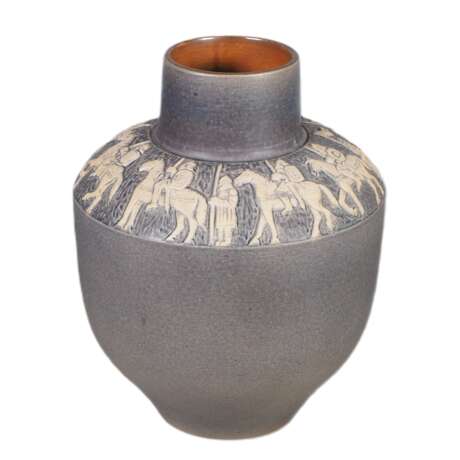ID 1236660
Lot 257 | Eugeniusz Niemirowski (1922-1998) Keramik-Kunstvase 70er Jahre.
Laut Wikipedia wurde Eugeniusz Niemirowski in Lemberg geboren. Nach dem Zweiten Weltkrieg ließ er sich in Wrocław nieder. Dort begann er sein Studium an der Staatlichen Hochschule für Bildende Künste in den Malateliers von Prof. Leon Dołżycki und Prof. Maria Dawska. Während seines Studiums wechselte er jedoch die Richtung und erwarb 1953 ein Diplom an der Fakultät für Glas und Keramik. Der Künstler befasste sich selbst mit allen Phasen der Keramikherstellung, von der Vorbereitung der Massen und Glasuren über den Entwurf und die Herstellung der Formen, deren Dekoration und Glasur bis hin zum Brennen. Er war vor allem für die Herstellung von künstlerischen Gebrauchsgegenständen wie Vasen, Tellern, Schalen und verschiedenen Gefäßen bekannt, die durch ihre einfachen Formen auffallen. Er verlieh ihnen einen einzigartigen Charakter, indem er Dekorationen in Form von Gemälden oder Reliefs anbrachte, die bewusst mit glatten Oberflächen kombiniert wurden, oft in kontrastierenden Farben. Am häufigsten verwendete er florale und tierische Motive sowie Genreszenen mit Figuren in stilisierten Trachten. Diese Dekorationen waren oft in kurzen thematischen Zyklen angeordnet, wie zum Beispiel "Ritter" oder "Musikanten". Eine gesonderte Gruppe von Werken besteht aus Gefäßen, bei denen die Glasuren des Autors, die in Farbe, Textur und Glanz variieren, der Hauptträger des ästhetischen Wertes sind.
E. Niemirowski ist auch als Schöpfer von originellen Reliefs und Relieffliesen bekannt geworden. Zu seinem Oeuvre gehören auch großformatige Skulpturen und anspruchsvolle farbige Gemälde auf Leinwand, die er jedoch nur selten auf Ausstellungen präsentiert.
| Auction house category: | Ceramic & Earthenware |
|---|
| Auction house category: | Ceramic & Earthenware |
|---|
| Address of auction |
Wersching Auktionen Luitpoldstr. 11 89231 Neu-Ulm Germany |
|---|---|
| Preview | |
| Phone | +4973125075036 |
| Fax | +49 731 250 760 88 |
| Buyer Premium | 25% |
| Conditions of purchase | Conditions of purchase |
| Shipping |
Postal service Courier service pickup by yourself |
| Payment methods |
Wire Transfer Credit card Cash |





